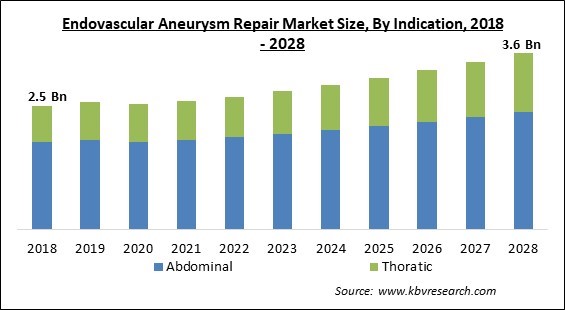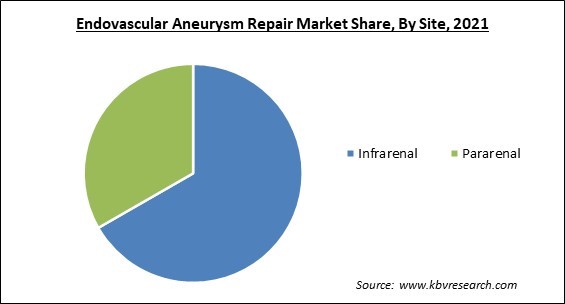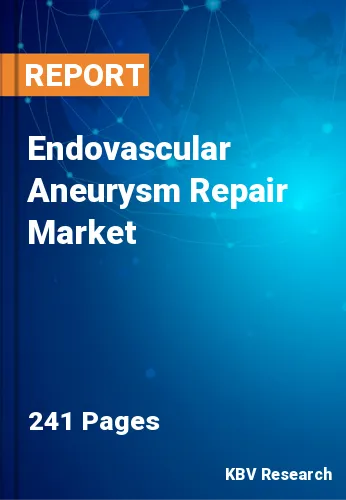The Global Endovascular Aneurysm Repair Market size is expected to reach $3.6 billion by 2028, rising at a market growth of 4.8% CAGR during the forecast period.
Endovascular aneurysm repair (EVAR) is the primary treatment option for aortic aneurysm because of its advantages over open surgery. Shorter hospital stays, faster recovery times, better patient outcomes, and no abdominal surgery are just a few of the benefits. As a result, the EVAR technique is now considered a routine intervention for abdominal aortic aneurysms (AAA). A stent is inserted into an aneurysmal section of the aorta to offer a permanent alternate path for blood flow inside the patient's vasculature, preventing the aneurysmal sac from rupturing due to blood flow pressure.
Although EVAR has greatly decreased surgical risks and recuperation time when compared to traditional open surgery, it is still possible to make improvements to the EVAR. Market companies, on the other hand, have developed next-generation and advanced technologies to handle such issues. Endologix Inc., for example, recently received FDA approval for its percutaneous endograft delivery system and has game-changing new-generation Nellix technology, the first and only endovascular sealing solution useful in mitigating all types of endoleak. Furthermore, the market for endovascular aneurysm repair benefits from the scope of technological advancement.
Due to the clear increasing incidence and prevalence of abdominal aortic aneurysm disease, the aging population, and the prevalence of cardiac illness and hypertension, the endovascular aneurysm repair market is predicted to rise substantially throughout the forecast period. One of the primary factors fueling the growth of the endovascular aneurysm repair market is the rising use of alcohol among the population, as well as an increase in smoking.
Additionally, governments all over the world are implementing a variety of programs to reduce costs and raise awareness about the availability of EVAR devices and treatment processes among patients. Healthcare institutions are responding by creating EVAR devices and technology that allow patients to recover faster and with fewer consequences. Improved graft technologies, for example, have been developed to provide treatments with short landing zones and improved conformability to artery curvature. These innovations have also contributed to an increase in the success rate of EVAR operations.

The outbreak of COVID-19 has had a negative impact on the endovascular aneurysm repair market. The COVID-19 pandemic has delayed the amount of persons seeking stroke and heart attack treatment in medical facilities around the world due to concerns about virus transmission. In addition, a number of hospitals have moved their focus to COVID-19 patients. For the time being, endovascular aneurysm repair therapies have been placed on hold or discontinued. The COVID-19 pandemic is expected to stifle growth in the endovascular aneurysm repair industry, as most hospitals remain closed as a result of COVID-19 and ongoing lockdowns in numerous countries. Patients with cardiac patients are at risk from the COVID-19 virus, which can be fatal.
When vessels smaller than 1 mm in diameter were imaged using single-slice spiral CT, computed tomography angiography (CTA) revolutionized vascular imaging. Aside from its limited invasiveness, CT Angiography offers cost savings and the potential for a reduction in the overall volume of contrast material used. Abdominal Computed Tomography Angiography can be performed with as little as 50 mL of contrast material and a saline flush using the fastest scanners currently available. Assessment of the abdominal aorta, preoperative and postoperative assessment for preoperative planning for hepatic segmentectomy and pancreatic surgery, kidney and liver transplantation, mesenteric ischemia, and gastrointestinal (GI) hemorrhage are some of the common abdominal applications of CTA.
Magnetic resonance angiography (MRA), like computed tomography angiography (CTA), has the advantage of allowing doctors to see the whole aorta, including its branch arteries. Unlike CTA, it does not expose the patient to radiation and does not require the use of iodinated contrast dye. Patients with a contrast allergy or renal insufficiency may find this more appealing. Non-gadolinium contrast agents are preferred in patients with renal disease. Blood pool contrast compounds, such as ferumoxytol, can be used to improve MRA and provide high-quality imaging.
Due to the involvement of various processes, patients receiving EVAR treatment are constantly at risk of developing renal impairment. Because of the large amounts of iodinated dye used, contrast-in-reduced nephropathy has been a major danger in these patients. Furthermore, throughout the deployment operation, there is a considerable chance of developing atheroemboli. Endoleaks, for example, have been reported as a delayed complication. The most prevalent delayed consequences of EVAR, according to recent investigations, are distal type I and type II endoleaks. Finally, these are primarily caused by suboptimal necks, landing zone enlargements, and stent-graft design and dimension features. The risks often scare the patients from seeking the right treatment and make them avoid going to the doctor.

Based on Indication, the market is segmented into Abdominal and Thoratic. The thoratic segment procured a substantial revenue share in the endovascular aneurysm repair market in 2021. The low occurrence of TAA and the lack of sophisticated devices for endovascular management can be linked to the constant development of the thoracic segment. Castor, for example, got permission from the China Food and Drug Administration (CFDA) in June 2017 for their thoracic stent graft system. It is the first stent-graft in the world to be created for simultaneous endovascular management of the thoracic aorta and major vessels of the arch.
Based on Product, the market is segmented into Percutaneous Evar, Fenestrated Evar, Aortic Stents & Taa Graft, and Others. The percutaneous EVAR segment acquired the maximum revenue share in the endovascular aneurysm repair market in 2021. The field of aortic repair has been revolutionized by percutaneous endovascular aortic repair (EVAR). Interventionalists continue to push the boundaries of what is possible as techniques and technology improve, allowing these life-saving treatments to be done on a larger spectrum of more technically complex situations. This would further accelerate the growth of the segment.
Based on Site, the market is segmented into Infrarenal and Pararenal. The pararenal segment procured a substantial revenue share in the endovascular aneurysm repair market in 2021. Aneurysm involving the underenal juxtarenal aorta (JRA), or more rarely, suprarenal aorta with normal aortic diameter at level of celiac trunk (JRA).
Based on Anatomy, the market is segmented into Traditional and Complex. The traditional segment acquired the largest revenue share in the endovascular aneurysm repair market in 2021. A lengthy incision is used to get access to and repair the aneurysm in traditional open surgery for abdominal aortic aneurysms and other forms of aneurysms. In addition, the increase in the investment by the governments in healthcare sector would spur the growth of the market.
| Report Attribute | Details |
|---|---|
| Market size value in 2021 | USD 2.6 Billion |
| Market size forecast in 2028 | USD 3.6 Billion |
| Base Year | 2021 |
| Historical Period | 2018 to 2020 |
| Forecast Period | 2022 to 2028 |
| Revenue Growth Rate | CAGR of 4.8% from 2022 to 2028 |
| Number of Pages | 234 |
| Number of Tables | 420 |
| Report coverage | Market Trends, Revenue Estimation and Forecast, Segmentation Analysis, Regional and Country Breakdown, Companies Strategic Developments, Company Profiling |
| Segments covered | Indication, Product, Site, Anatomy, Region |
| Country scope | US, Canada, Mexico, Germany, UK, France, Russia, Spain, Italy, China, Japan, India, South Korea, Singapore, Malaysia, Brazil, Argentina, UAE, Saudi Arabia, South Africa, Nigeria |
| Growth Drivers |
|
| Restraints |
|
Based on Regions, the market is segmented into North America, Europe, Asia Pacific, and Latin America, Middle East & Africa. North America acquired the highest revenue share in endovascular aneurysm repair market in 2021. This is due to an increase in the number of endovascular aneurysm repair treatments in the United States. There is an increase in the number of EVAR procedures performed in the United States. In these countries, technological breakthroughs are paving the way for the development of cost-effective devices, creating a profitable market for endovascular aneurysm repair.
Free Valuable Insights: Global Endovascular Aneurysm Repair Market size to reach USD 3.6 Billion by 2028
The market research report covers the analysis of key stake holders of the market. Key companies profiled in the report include Endologix LLC, Lombard Medical Limited, Cardinal Health, Inc., Becton, Dickinson and Company, Medtronic PLC, Cook Medical, Inc., Koninklijke Philips N.V., Terumo Corporation, Abbott Laboratories, and Artivion, Inc.By Indication
By Product
By Site
By Anatomy
By Geography
The global endovascular aneurysm repair market size is expected to reach $3.6 billion by 2028.
Rising application of abdominal computed tomography angiography are increasing are driving the market in coming years, however, tate or immediate medical complications post-intervention growth of the market.
Endologix LLC, Lombard Medical Limited, Cardinal Health, Inc., Becton, Dickinson and Company, Medtronic PLC, Cook Medical, Inc., Koninklijke Philips N.V., Terumo Corporation, Abbott Laboratories, and Artivion, Inc.
The Abdominal segment is leading the Global Endovascular Aneurysm Repair Market by Indication in 2021, thereby, achieving a market value of $2.3 billion by 2028.
The Infrarenal segment acquired maximum revenue share in the Global Endovascular Aneurysm Repair Market by Site in 2021; thereby, achieving a market value of $2.2 billion by 2028.
The North America market dominated the Global Endovascular Aneurysm Repair Market by Region in 2021, and would continue to be a dominant market till 2028.
Our team of dedicated experts can provide you with attractive expansion opportunities for your business.

